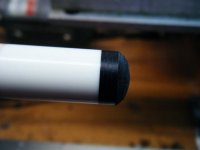Here is a couple I just did.
Taken with a 100mm Canon macro lens.


The first picture is a Tiger tip, the second is a Zan Premium Soft with a clear acryllic pad.
My way:
- Face of the ferrule
- Clean the ferrule with fast orange hand cleaner
- Scuff the tip
- Center the shaft in the chuck
- Glue tip on with Loctite 401
- Leave on the lathe with slight pressure from the headstock about 15 minutes
- Take down about 50% of the excess tip overhang with sharp carbide bit
- Put a drop of water on the tip
- Use a sharp blade and trim the tip flush
- Shape the tip to dime or nickel shape with a sharp razor
- Sand the tip perfect with the ferrule 800, 1200, 2000grit
- Check tip diameter compared to ferrule diameter with a micrometer
- Burnish sides with wax or burnishing liquid
- Polish the ferrule with 3000 grit and then Mirka fine polish
Taken with a 100mm Canon macro lens.


The first picture is a Tiger tip, the second is a Zan Premium Soft with a clear acryllic pad.
My way:
- Face of the ferrule
- Clean the ferrule with fast orange hand cleaner
- Scuff the tip
- Center the shaft in the chuck
- Glue tip on with Loctite 401
- Leave on the lathe with slight pressure from the headstock about 15 minutes
- Take down about 50% of the excess tip overhang with sharp carbide bit
- Put a drop of water on the tip
- Use a sharp blade and trim the tip flush
- Shape the tip to dime or nickel shape with a sharp razor
- Sand the tip perfect with the ferrule 800, 1200, 2000grit
- Check tip diameter compared to ferrule diameter with a micrometer
- Burnish sides with wax or burnishing liquid
- Polish the ferrule with 3000 grit and then Mirka fine polish
